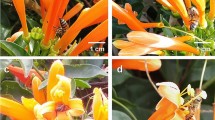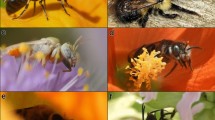Summary
Wasps (Dolichovespula and Vespula spp.) worked predominantly upwards when foraging for nectar on inflorescences of the protogynous Scrophularia aquatica, in which the standing crop of nectar sugar per flower showed no clear pattern of vertical distribution up an inflorescence. Bumblebees taking nectar (Bombus hortorum visiting legally, and certain individuals of B. terrestris which positioned themselves head-upwards while taking nectar through holes bitten in the corolla) worked predominantly upwards on the racemose inflorescences of Linaria vulgaris, although the standing crop of nectar sugar per open flower increased up the raceme. Individuals of B. terrestris which robbed Linaria flowers in a head-down position worked predominantly downwards on inflorescences. The upward or downward directionality of intra-inflorescence movements by foraging insects may depend in part on the position these adopt during their flower visits.
Similar content being viewed by others
References
Avebury Lord (1909) British wild flowers in relation to insects. MacMillan & Co Ltd, London
Benson L (1979) Plant classification (2nd ed). DC Heath & Co, Lexington, Massachusetts
Faegri K, van der Pijl L (1979) The principles of pollination ecology (3rd ed). Pergamon Press
Knuth P (1909) Handbook of flower pollination. Vol III. Trans JR Ainsworth Davis, Oxford
Müller H (1883) The fertilisation of flowers. London: MacMillan & Co
Pyke GH (1978) Optimal foraging in bumblebees and coevolution with their plants. Oecologia (Berl) 36:281–293
Pyke GH (1979) Optimal foraging in bumblebees: rule of movement between flowers within inflorescences. Animal Behaviour 27:1167–1181
Raw GR (1953) The effect on nectar secretion of removing nectar from flowers. Bee World 34:23–25
Trelease W (1881) The fertilization of Scrophularia. Bull Torrey Bot Club 8:133–140
Waddington KD, Heinrich B (1979) The foraging movements of bumblebees on vertical “inflorescences”: an experimental analysis. J Comp Physiol 134:113–117
Wilson A (1878) On the association of an inconspicuous corolla with protogynous dichogamy in insect-fertilised flowers. Nature, Lond 18:508–509
Author information
Authors and Affiliations
Rights and permissions
About this article
Cite this article
Corbet, S.A., Cuthill, I., Fallows, M. et al. Why do nectar-foraging bees and wasps work upwards on inflorescences?. Oecologia 51, 79–83 (1981). https://doi.org/10.1007/BF00344656
Received:
Issue Date:
DOI: https://doi.org/10.1007/BF00344656




